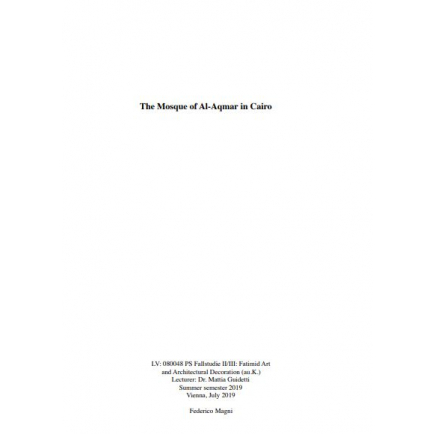
The Mosque of Al-Aqmar in Cairo
تاريخ الاضافة
01/07/2022
نوع المحتوى
Documentary
Category
Researches
الرابط للمحتوى
Subject Area
Mosques
الكاتب
FEDERICO MAGNI
الناشر
University of Vienna
Year of Publication
2019
الوصف
In the city of Al-Qaira, the Fatimid nucleus of the pre-existing Fustat, conquered in 969, it is
possible to trace back some of the original configuration of the city plan that was based on the
palace complex that consisted in a fifth of the total area of the city according to Ravaisse,
divided into western Palace and Eastern Great Palace. It is in this very central nucleus,
divided into two urban agglomerates by the main street that goes from the gateway of Bab alFutuh and the Mosque of al-Hakim to the southern gateway of Bab Zuwayla (from north to
south), that the Mosque of Al-Aqmar finds his place, just to the right to the original place of
the eastern palace that no longer exists, being probably destroyed by later conquerors of the
city (Img.1). It has been built by the vizier al-Ma’mun al Bata’ihi in 1125 under the approval
of the vizier and since then it has been considered one of the most unique and valuable
examples of Fatimid religious architecture still surviving. The façade is the most important
element in the overall structure, featuring characteristics that will influence the following
periods of architectural production and stimulating different arguments regarding the
interpretation of its decorative elements, that appear unexplored and mysterious, being almost
all the sources of Shi’a cults destroyed by later Sunnis invasions, but relying on a well
documented historical path, thanks to the writings of the son of the vizier al-Ma’mun. The
renovation and partial building of the Mosque was done alongside a period of new flourishing
of the Fatimid Caliphate after the economic and social crises that occurred during the
vizierate of al Mustansir that affected also the conservation of religious and civil buildings
resulting in the decay of them, from this the necessity of the restoration. Starting from the
formal description of the façade it will be possible to analyze how the scholars tried to
interpret the decorations in a context of ceremonial functions or cult of ‘Alid Saints, all major
features of the Fatimid Caliphate in Cairo around 1125.





